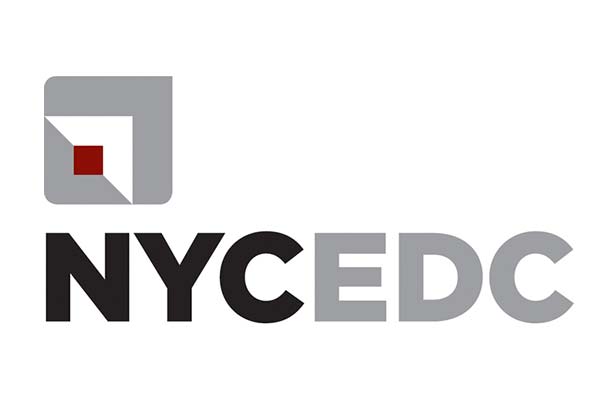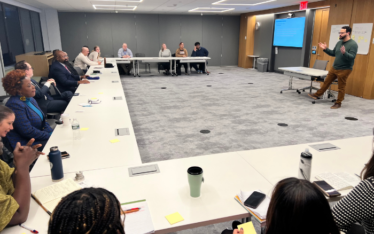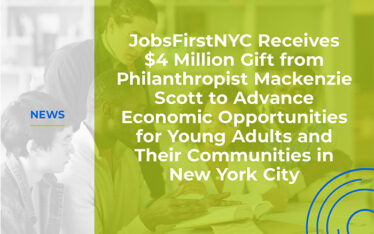Testimony of Marjorie D. Parker, President, and CEO of JobsFirstNYC before the New York City Council Committee on Economic Development for a Hearing on NYCEDC’s Relief Efforts During the COVID-19 Crisis held on June 24, 2020
Good afternoon Chairperson Paul Vallone and distinguished members of the Committee on Economic Development. My name is Marjorie Parker and I am the President and CEO of JobsFirstNYC, a non-profit intermediary that creates and advances solutions that break down barriers and transform the systems supporting young adults and their communities in the pursuit of economic opportunities.
To understand the breadth of the COVID-19 economic impact on young adults, their communities, and the organizations that support them, JobsFirstNYC shared a survey and conducted interviews with leaders from 68 of our partner institutions. The resulting paper, The Early Impact of COVID-19 on Young Adult Workforce Development: Insights from the Field, shares the insights we collected, articulates emerging questions that the young adult workforce development field is now grappling with, and offers recommendations to ensure that young adults and their communities are not left behind. A link to the report and the Executive Summary are included at the end of this testimony for your review.
Informed by this report and our more than 14 years of experience, we outline three recommendations that the NYC Economic Development Corporation and the NYC Council Economic Development Committee should pursue.
Recommendation 1, Invest in Place-Based Solutions:
For over a decade, JobsFirstNYC has taken an intentionally place-based approach to its systems transformation work, supporting community-led partnerships in the neighborhoods with the highest rates of out-of-school, out-of-work young adults. These rates vary from 5% in Greenwich Village to 34% in the South Bronx. This strategy, rooted in community-designed solutions, allows us to allocate resources, capacity, and time to the areas of the city where we can have the most impact. Just as the city’s Restaurant Revitalization Program is restricted to the 27 communities hardest hit by the pandemic, we recommend that the Economic Development Corporation’s COVID-19 relief efforts are hyper-localized, focusing on the communities that suffered the highest rates of infection and death from the coronavirus. As public health data has shown, the communities most affected by COVID-19 were already suffering from lack of investment and many residents were struggling to achieve economic mobility. By targeting relief efforts to these neighborhoods and activating local sites for manufacturing, an EDC focus area made even more important in light of supply chain disruptions caused by the pandemic, modern skills training, and job creation in these communities, the EDC would spark inclusive economic growth by supporting resident economic mobility, entrepreneurship and business development, turning short-term relief efforts into a long-term resiliency plan.
In order to ensure that these localized investments are most beneficial to historical residents, there must be a mechanism to prepare them for and place them in any jobs being created. One example of an effective model is the Lower East Side Employment Network (LESEN), which was created in 2007 in response to a rezoning of the neighborhood and an influx of hospitality development. This partnership, made up of eight nonprofits and the community board, works closely with the hospitality sector to design customized training programs and streamline recruiting processes for hotels and related businesses. We recommend that any targeted, community investments create and support similar mechanisms to join together employers and local workforce development agencies so that residents have the skills and connections needed to access the jobs that are being created. These infrastructures are critical to leveraging and connecting limited resources and strained capacity.
Recommendation 2, Prioritize Young Adults:
Special attention should be given to ensuring that young adults, in particular, are able to connect to new employment opportunities, given that the communities most affected by COVID-19 also have disproportionately high out-of-school out-of-work rates.
If we have learned anything from the Great Recession just a decade ago, it’s that young adult generations that enter the labor market in an economic downturn are at a serious disadvantage, impacting their ability to successfully launch a career and reach financial security and self-sufficiency like the generations before them. Members of the Millennial generation, people who came of age during the Great Recession, make 20 percent less in wages and have a net wealth that’s half as much as their Baby Boomer parents. In New York City, the economic future is threatened by a declining young adult population.
Recommendation 3, Provide Immediate Support to Small Businesses:
Many small businesses were unable to take advantage of federal programs and do not have the capital to support sustained closure and reduced economic activity. Some were further impacted by the recent lootings. These businesses are particularly vulnerable and frequently the owners do not meet the basic requirements of stimulus and assistance programs. For example, only 1% of the businesses in the Bronx received COVID-19 relief funds. They need access to funds, business development tools, investments for job creation opportunities, and public-private partnerships to revitalize the local economy in neighborhoods throughout the Bronx.
One example of the opportunity to spark local economic growth is the recently rezoned area of the Jerome Avenue corridor with over 400 businesses cutting across 3 community districts. We encourage the EDC to partner with The Jerome Avenue Revitalization Collaborative (JARC), a new partnership supported by JobsFirstNYC, created in response to the rezoning. A combination of housing and economic development, anchor institutions, nonprofit organizations, the local community college, and merchant associations are in the process of designing a business support hub to provide targeted assistance to local businesses, including those who may not have the access to capital financial/digital tools or certifications/skills they need to remain competitive and thrive with the evolving economy. We recommend that any EDC strategy to support business access to the city, state, and federal stimulus programs, includes similar support and education for small and micro business owners who may be locked out of these programs due to knowledge gaps where government processes or requirements fail to align with the realities of the businesses. This is another approach that moves from relief to resiliency, as these businesses will be better prepared to benefit from government stimulus programs during future crises.
In closing, any COVID-19 economic relief strategy must take a hyperlocal approach in the neighborhoods most affected, ensure that mechanisms are in place to connect local residents, especially young adults, of these neighborhoods to any jobs created, and support the city’s smallest businesses to gain the knowledge and resources they need to access government-sponsored economic recovery programs. Without these three elements, relief efforts will leave behind those who have suffered the most from this pandemic.
Thank you for your time and consideration. We appreciate the opportunity to testify and look forward to working with each of you to enact these recommendations and ensure that all New Yorkers benefit from the EDC’s COVID-19 relief efforts.
The Early Impact of COVID-19 on Young Adult Workforce Development: Insights from the Field, a JobsFirstNYC working paper published on May 20, 2020. Highlights:
7 Insights from the Field
- Household finances are declining rapidly as COVID-19 exacerbates preexisting inequalities in the areas of food, housing, health, and financial insecurity.
- Having a job has become a matter of life and death, not just employment.
- The pandemic is causing young adults to face greater competition for jobs, internships, and work-based learning experiences.
- Young adults and nonprofit staff are facing rising mental and physical health needs.
- The transition to remote teaching and learning is not meeting all of the needs of young adults and will negatively affect their skills training and educational progress.
- Funding is flexible right now, but nonprofits are bracing for drastic public funding cuts.
- The future of the labor market is uncertain, leaving workforce providers and jobseekers without a roadmap.
3 Emerging Questions
- How can the workforce development field better prepare young adults for shifts in the labor market brought on by the global pandemic?
- What innovations can curb the impact of reduced staffing, layoffs, and loss of talent on the nonprofit sector?
- How does the workforce development field become more engaged in policy decisions on economic rebuilding at the city and state level?
6 Immediate-term recommendations
- Hold the line on cutting funding for critical programs and convert current funding to general operating support for at least the next year.
- Create opportunities for the workforce development field to rightsize its organizations.
- Invest in mental health counseling and support services.
- Invest in institutional partnerships between the workforce and educational systems.
- Map in-demand skills and partner with employers to develop new strategies to improve educational and training programs for young adults.
- Young adult workforce development advocacy must call for significant investment in big ideas and emphasize low-income communities.





